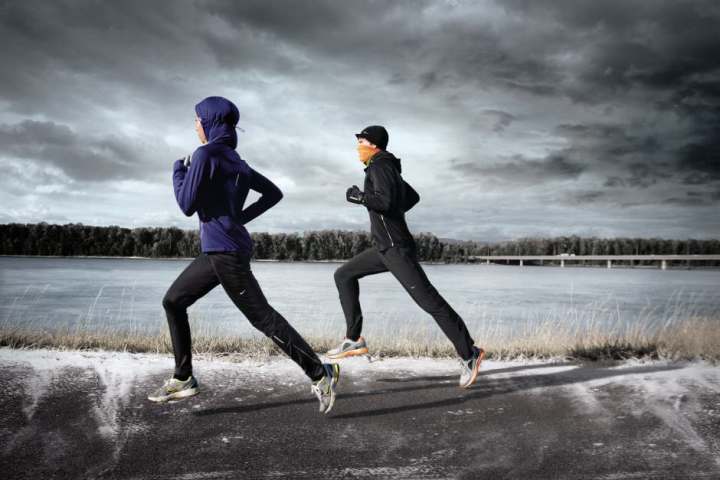There's a question many people ask when training in cold weather: Is it really possible to burn more calories in this environment?
When training outdoors in winter, people tend to bundle up in order to keep the body at a stable temperature, but as we exercise the body tends to heat up. In fact, it is very likely that you are sweating much less than you normally would in summer weather, but depending on the temperature you may be shivering or sweating.
Know if a cold outdoor workout burns more calories or not.

What happens when training in low temperatures?
When training in cold weather, what happens to the body is not much different from exercising in cool temperatures. At first, your body will be cold, but as you begin to train you can produce enough heat, avoiding hypothermia.
Experts indicate that the most notable difference is the workout clothes. Some athletes train in cold climates with short clothing in order to get enough exercise to keep their bodies warm, thus burning many more calories. However, it should be noted that the amount of heat generated by the body with exercise may not be enough to maintain body temperature, so it is recommended to do it with the indicated clothing.
In conclusion, it can be said that exercising with little clothing in winter can cause hypothermia and frostbite. Therefore, it is recommended to use gloves and a hat apart from the common clothing.

When you tremble, are you burning calories?
Being in cold climates, the body tries to warm itself naturally through tremors, whether you are sitting waiting for a bus or running a few miles.
The tremors would be a response similar to "sweating", but these occur when it is very cold. Simply put, you sweat to get rid of the heat and you shiver to generate heat . But, while sweating doesn't burn calories as many people think, shaking does.
According to a study published in Cell Metabolism , shaking for 10 to 15 minutes can be comparable to an hour of moderate exercise. However, simply being cold is not considered a reliable method of burning calories for weight loss (Lee et al., 2014).

Does brown fat affect calorie burning?
It wasn't until recently that only small rodents and human babies had brown adipose tissue (brown fat), which helps the body stay warm without shivering. But now it's clear that adults have brown fat too , and it's proven to be an effective way to keep your body warm.
Cold temperatures help activate the body's brown fat stores , which help generate heat without having to do any additional work. The good thing about this is that you can increase heat production without having to feel shaky.
The amount of calories that are burned additionally by the activation or trembling of brown fat is not very high. For example, if you go for a run for about 30 to 45 minutes, you don't think you're talking about a difference of more than 100 calories.
Simply put, exercising in the cold burns calories , but not necessarily more than in other conditions. The exception is if you are not dressed appropriately to train in cold weather. If you're not wearing enough clothing, your body increases heat production, and that extra heat helps burn more calories from the brown fat.

How to increase the activity of brown fat
Just as people train the body and mind to strengthen them, you can also "train" your body's brown fat stores to improve heat generation, burning calories, exposing yourself to cold weather.
According to a study conducted by the Journal of Clinical Endocrinology and Metabolism, it was determined that 4 weeks of exposure to cold resulted in a 45% increase in the volume of brown fat activity (Blondin et al., 2014). On the other hand, another study from the Journal of Clinical Investigation found that frequent exposure to cold could be an effective way to increase the activity of brown fat and the consequent burning of calories (Van der Lans et al., 2013).
The research on brown fat is interesting, but it is quite early in terms of understanding the significance of these observed changes.

conclusion
Exercising outside in cold climates doesn't have much of a difference in calorie burn than exercising in much warmer weather. The main difference lies in exercising in the wrong clothing in the cold, causing your body to try to generate more heat through tremors or by activating brown fat. However, training in cold temperatures with little clothing is not recommended as it can cause hypothermia.
References
- Blondin, D., Labbé, S., Tingelstad, H., Noll, C., Kunach, M., Phoenix, S., Guérin, B… Turcotte, E. (2014). Increased brown adipose tissue oxidative capacity in cold-acclimated humans. The Journal of Clinical Endocrinology and Metabolism. doi: 10.1210 / jc.2013-3901
- Lee, P., Linderman, J., Smith, S., Brychta, R., Wang, J., Idelson, C., Perron, R… Werner, C. (2014). Irisin and FGF21 are cold-induced endocrine activators of brown fat function in humans. Cell Metabolism. doi: 10.1016 / j.cmet.2013.12.017
- Van der Lans, A., Hoeks, J., Brans, B., Vijgen, G., Visser, M., Vosselman, M., Hansen, J… Jörgensen, J. (2013). Cold acclimation recruits human brown fat and increases nonshivering thermogenesis. The Journal of Clinical Investigation . doi: 10.1172 / JCI68993
